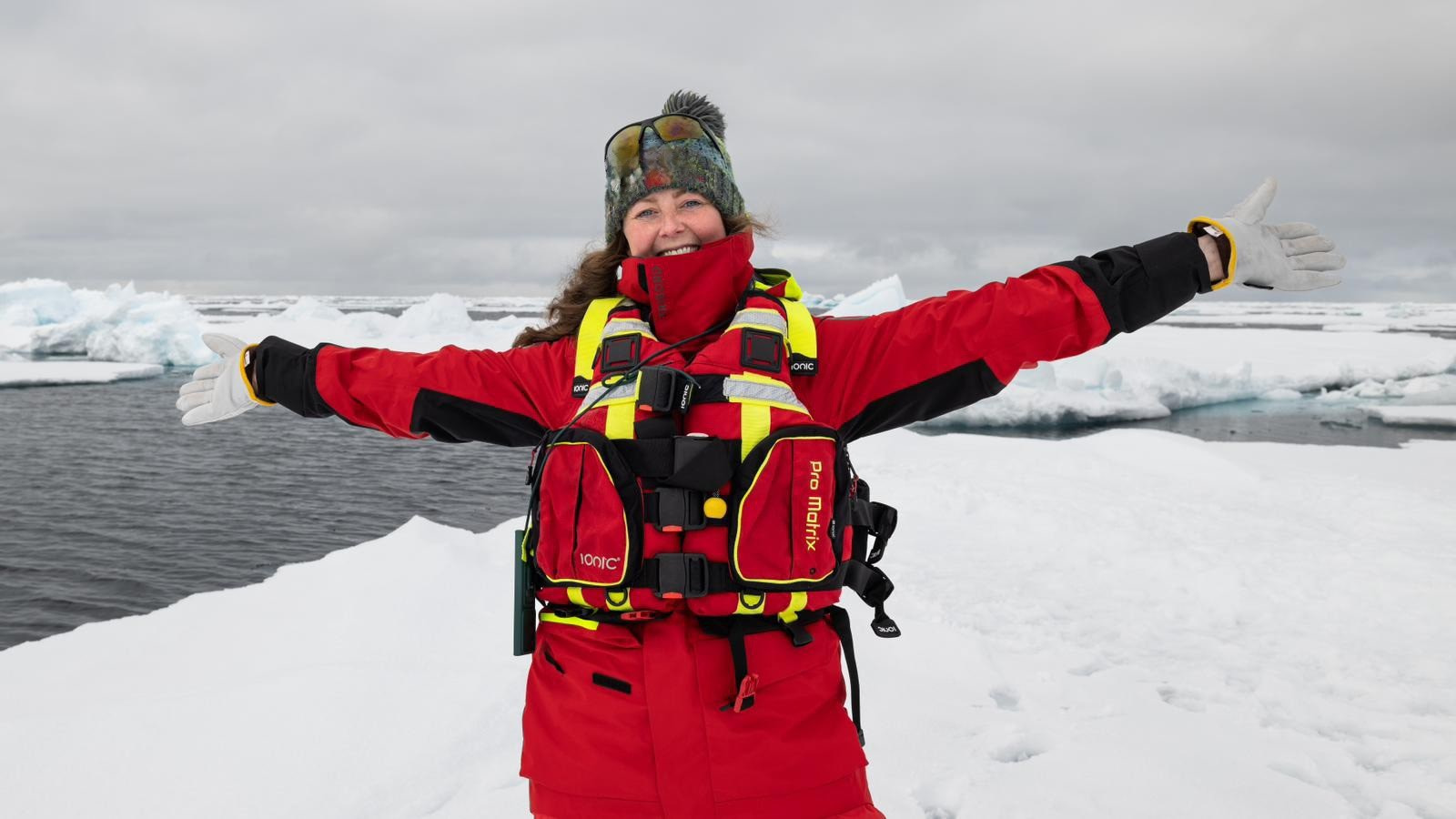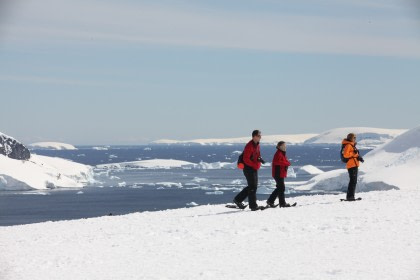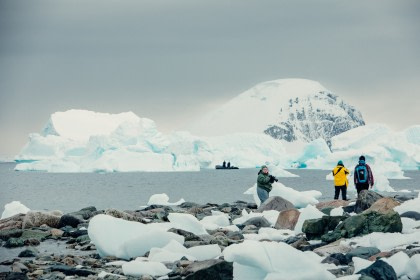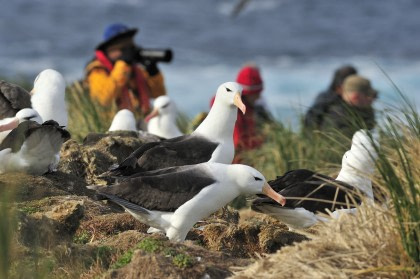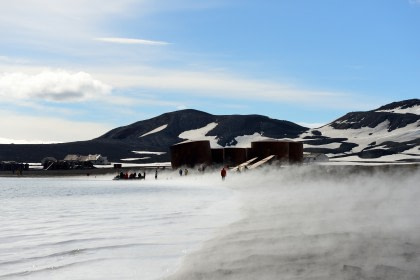An expedition guide’s research into marine mammal acoustics – and why they matter
Many of our guides cut their teeth in the science world. In fact, it’s typically their background in the sciences that first puts us into contact.
Ranging from postdocs in Arctic glaciology to full-fledged field staff overwintering at Antarctic research stations, these science-steeped professionals make great guides. They’re also especially suited to giving a variety of fascinating presentations to our guests.
Biologist Ashleigh Kitchiner is a prime example, and her lectures on marine mammal acoustics are as interesting as they are relevant to planetary health.
Ashleigh’s preferred marine mammal is the bowhead whale, which she has studied extensively, though she also does regular work with energy developers to ensure marine wildlife guidelines are met at offshore and near-shore projects.
We spent some time talking to Ashleigh about her work as an expedition guide, what got her into biology, and why bowhead whale sounds are so interesting.
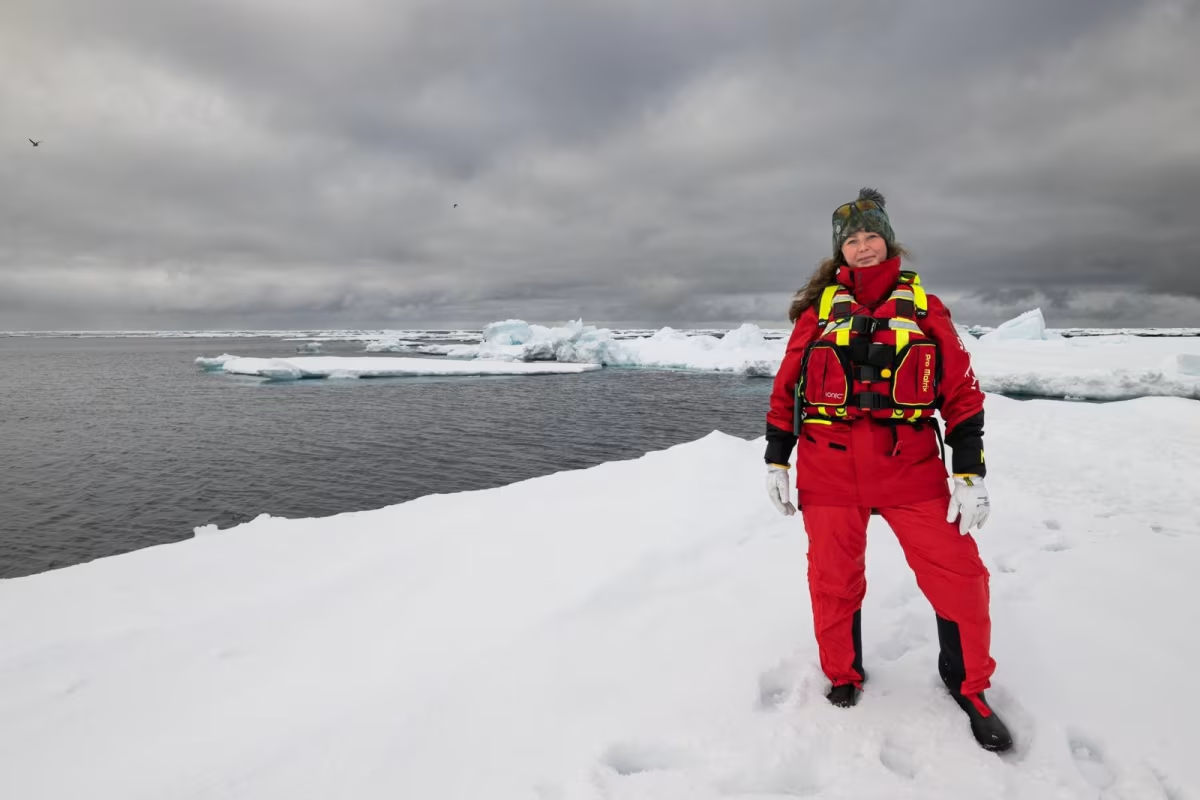
Picture by Ashleigh Kitchiner
Take us into your area of research. What exactly do you study?
A lot of my work is based on acoustics, because marine mammals are very sensitive to underwater noise. Even fish can be sensitive to vibration. This is something that always needs to be factored into industry operations.
That’s where I come in. It has been part of my job for a long time, analyzing marine mammal acoustics to learn about a range of topics. This is also why I wanted to do an acoustics workshop with Oceanwide, which we do by using a hydrophone.
What do you do in the acoustic workshop?
First I introduce the topic, and after I’ve played a few animal sound clips for the guests, they do a quiz in which they identify the species based on sound. Guests really like that.
Some of the sounds are quite alien, like the leopard seal and Weddell seal. And in the Arctic, you’ve got bowhead whales that have to compete with the sound of the ice. The ice is very noisy, so bowheads have to use really intricate vocalizations. Some people have compared it to jazz music.
It’s very unlike the humpback whale, which makes sounds more like the whale songs people are used to hearing. Bowhead whale sounds are more jarring, more up and down.

Picture by Sara Jenner
So they don’t use bowhead songs as much in New Age music.
Not as much. When I play these vocalizations to people, a lot of them say they sound like they’re coming from outer space. They really can sound alien. But analyzing these sounds helps us understand how healthy these marine mammal communities are.
There are natural sounds that disturb marine mammals: thunder, volcanic eruptions, earthquakes, things like that. But on top of that, all the acoustic disturbance we make as humans is exponentially increasing and having an impact on their world.
Do you specialize in bowhead whales?
No, but they are my favorite cetacean. I read a lot about them. The other researcher I was delivering the acoustics workshop with, Herman, specializes in bowheads and is raising money to bring a vessel into an area where scientists once recorded a cacophony of bowhead sounds. The species isn’t known to be there, so he wants to see if it’s a special mating spot that needs to be protected from shipping routes.
Bowhead whales are fascinating because we know so little about them. They spend most of their lives under the ice, and we’re not sure what they do or where they go. They’re the only large whale that lives in the Arctic through the whole year.

Picture by Marijke de Boer
Have your Antarctica trips been as rewarding as the Arctic ones?
The volume of wildlife you see in Antarctica is amazing. The mass of animals, especially in South Georgia, is just insane. But I prefer the Arctic if only for the bowhead whales.
My first trip as an Oceanwide guide was to the Arctic in June 2023. I had done cruise guiding before, but not on an expedition cruise. It’s much more hands-on here, which I prefer. And I love sharing what I’ve learned about nature conservation with the guests. The type of people who go on expedition cruises seem very receptive to it.
When I was studying biology at university, I kept choosing nature and conservation modules but didn’t know anybody who worked in that sector. I didn’t know if you could have a career in conservation, at least not one where you could earn a living.
I wanted to do something good, but I also had to earn enough to live. But when I finally started meeting people who worked in the field, it was life changing. That was when I said to myself, “Okay, this is definitely something I want to do.”
What was it that first sparked your interest in studying marine mammals?
I have always loved whales and dolphins. What kid doesn’t? At first I thought I might just volunteer in animal conservation if I couldn’t get a job doing it. But my interest must have been pretty obvious, because I recently ran into a friend I knew in primary school who asked me, “So are you working with whales and dolphins?”
She remembered how often I said that this was what I was going to do. It was nice to hear this little bit of reinforcement, because before university I sort of lost sight of it for a while – hence my decision to study biology and not marine biology. But it means I ended up where I originally wanted to be.

Picture by Ashleigh Kitchiner
How do you divide your time between research and guide work?
I’m a self-employed freelancer, as a lot of guides are. This allows me to do a lot of industry work as well. Working as an expedition guide, you’re usually booked a year in advance. But industry workers might need you offshore tomorrow. It’s really last minute. So I do about three months of expedition work per year and leave the rest open for industry jobs.
Both cruising and industry jobs are booming, and everybody’s trying to get to net-zero soon. That means a new green industry revolution, a gradual takeover of renewables.
This is sorely needed. We need to build offshore wind farms, offshore solar, and underwater turbines. But if you’re installing any type of energy device in the marine environment, you need marine mammal specialists on site to make sure you’re not doing more harm than good.
For example, I’ll be working in the North Sea soon on a geophysical survey. The developers are installing a wind farm, and they need to know what the seabed is like to determine the best spots for turbines and the hammer energy needed to install them.
They’re doing this work close to a protected site, so I’m there as their marine mammal specialist to enable the protection of the wildlife there. Every country has different rules about wildlife disturbance. It’s my job to make sure those rules are enforced and the animals protected.
This must give you a lot to talk about in your Oceanwide presentations.
Yes, but I’m always looking for ways to make my presentations different. For example, I’m really interested in literature and the arts, so I thought of combining them in my talks. I’m currently studying highlands and island literature and wanted to fuse my passions. Marine mammals play important roles in art and literature, so we’ll see how that goes.
You’re talking to someone with a background in literature (and is a huge fan of Moby Dick), so I think it sounds fascinating.
Thanks, that’s good feedback. Nobody else is doing it, so it’s worth a try. I think it’s always important to try to communicate things you’re genuinely interested in and try different ways of telling the story of marine mammals.

Picture by Ashleigh Kitchiner
Agreed. With that in mind, let’s end on an example: what is your favorite thing about being an expedition guide?
Showing people the animals. Guests are always so happy to see them, especially when it’s the first whale or polar bear. Every trip varies, and you get different crowds, but I love working with expedition cruise guests.
The people I meet on an Oceanwide Expeditions voyage usually have some scientific knowledge or at least appreciation for it. They tend to be open-minded and are excited to be there, and the guides always do their best to make every trip as eventful as possible.
So yes, my favorite thing is showing guests the animals – them seeing my reaction, me seeing theirs. Having that connection is magical. I don’t think you can beat it.
Main image by Ashleigh Kitchiner
